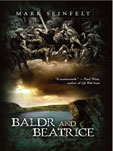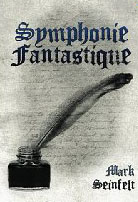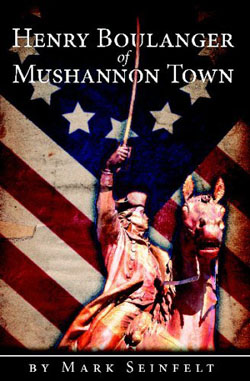|
|
Books |
| |
|

click for larger image |
Baldr and Beatrice
Purchase - Amazon.com
A rich and subtle analysis of the psychology of friendship and love, Mark Seinfelt’s Baldr and Beatrice–a novel at turns philosophical, allegorical, mythical, and spiritual–revisits the old, time-proven narrative formula of boy and girl forever desiring but never fully achieving the culmination of their love. Here, it is a matter of their accidental disuniting as primordial essences, depicted in grand Miltonic flourishes, through severing time warps and their reemergence in different times, places, and cultures. As the novel opens, in the Upper Circles or the eternal Summerlands, Baldr and Beatrice’s spirits, prior to their incarnation on earth, decide to partake directly in the All Highest’s continuous act of kaleidoscopic creation and to perform as agents of that creation, something that can occur only in the sublunary world. They chose to take their births in the Landgraviate of Thuringia in medieval, semi-pagan Germany. However, a spiteful shadow-being diverts Baldr elsewhere, to indigenous “Indian” America, where he is adopted by the Ho-Chunk deity Red Horn. As a young girl, Beatrice inadvertently summons his unborn soul to her across space and time when she enters a witches’ circle cast by her grandmother Oma, who practices the old ways despite the interdiction of her son, the Christian Landgrave. For a time, as children, the spirit boy and the flesh-and-blood girl lead an idyllic existence, but circumstances force Oma to separate them and send Baldr back to Indian America, where he appears now as a human boy but casts no shadow. As Baldr grows to manhood (generations of Indians live and die in the interval), wave after wave of white settlers begin pouring into the pristine Indian territory. Red Horn realizes that the world is out of balance because of Baldr’s separation from Beatrice and aids his son in returning to medieval Thuringia, where tragedy ensues because of Baldr’s lack of a shadow. The grotesque admixture of prevailing superstition and custom with new faith is depicted in both European and American spheres in this sad, comic, tears-through chuckles tale. Baldr and Beatrice exemplifies the very best in narrative art, combining wit, imagination, history and insight into the nature of love, and discloses the influence of such beloved American authors as Barth, Vonnegut, West and Pynchon. Indeed Paul West says of Baldr and Beatrice: “It invokes Thomas Mann and the sermons of John Donne. How does Mr. Seinfelt do it? By keeping it all in his head, as if the whole novel were to come alive and swamp the remainder? I wish to congratulate the author on the splendiferous plentitude that always keeps itself from excess.” Al Galasso of the North American Bookdealers Exchange also hails the novel: “Award-winning author Mark Seinfelt has taken his descriptive talents to an unusual new work entitled Baldr and Beatrice. It takes readers on a time machine into the human psyche.” |

click for larger image |
Final Drafts: suicides of world-famous authors
Purchase - Amazon.com
Final Drafts is both a biographical treatment and a psychological examination of the authors of the past century who left this world on their own terms. It is also a devoted examination of references to suicide in literature, both in the authors’ own communications and in the stories of writers who contemplated suicide but dared to live. In his foreword to the book, Paul West wrote: “This disturbing, thorough study of literary suicide in the twentieth century is an epoch-making book, sad but generously expansive: a book we have always needed.” The Midwest Book Review issued Final Drafts a five-star rating, characterizing it as “unique, fascinating, informative reading.... Some of the greatest writers in the world chose an untimely death by suicide, and this charts their lives and psychological conditions. It’s hard to easily categorize this treatise, which considers both their literary lives and psychology; but any studying such writers from Anne Sexton and Ernest Hemingway to the more modern Michael Dorris, will find Final Drafts an important survey covering more than a century of literary figures.” Writing in Book Page, the critic Randall Curb hailed Final Drafts as an “intriguing bedside-table book.... The stories are necessarily grim and disturbing, but the subjects rarely fail to fascinate.” In Oakland Press, Ginny Stolicker wrote that while “the focus of the book may be the suicides of respected writers, Seinfelt offers much more.” Phyllis Straughan of Book Browsing found the book “intriguing.” Today’s Books of Public News Services called it “exceptional.”
Authors have always been particularly susceptible to the suicidal impulse, the most gifted and lionized as well as the least talented and the least successful. Suicide, the final taboo, has often fueled their literary art. From antiquity to the present, writers have immortalized the self-induced deaths of both historical and fictional characters: Virgil’s Dido, Shakespeare’s Anthony and Cleopatra, Tolstoy’s Anna Karenina, and Mann’s Gustave von Aschenbach. Author suicides have been recorded throughout history. However, since the nineteenth century, possibly due to romantic notions of the artist’s alienation from society, or the alleged creative dimension of impending death, a significant wave of author suicides has occurred and continues unabated. Many writers who did not kill themselves outright lived in such a reckless and self-destructive fashion, abusing drugs and alcohol or deliberately putting themselves in harm’s way, that they could be termed “psychological suicides.” Are these self-destructive urges simply “artistic temperament,” or has the past century, with its global wars and crises and profound societal changes, proved too violent and dehumanizing an age for such sensitive and creative souls?
In Final Drafts: Suicides of World-Famous Authors, writer Mark Seinfelt examines in depth the lives and deaths of twenty-five authors who killed themselves between 1894 and 1991. The most famous suicides, such as Ernest Hemingway, Virginia Woolf, and Sylvia Plath, are included; but along with these are others whose art and manner of death are not so well known: Constance F. Woolson, grand-niece of James Fenimore Cooper and protégée of Henry James, who, one winter morning in Venice, leapt to her death from her second-story bedroom window; émigré Austrian writer Stefan Zweig, who committed joint suicide with his wife in despair over the future of Nazi-occupied Europe; and John Kennedy Toole, whose Pulitzer Prize-winning novel, A Confederacy of Dunces, was published only after his mother doggedly convinced Walker Percy to read the “badly smeared, scarcely readable carbon” left behind among her son’s effects. Also featured is Adolf Hitler, whose inclusion may be surprising but is indeed apt: an avid student of Richard Wagner, whose concept of “total art” influenced generations of writers and composers, Hitler sought to recast all of Germany into the colossal and grotesque image he created in Mein Kampf. Seinfelt adds to his roster seven “possible suicides” and twenty-four others who ended their own lives.
The list is long. Each of the artists who took his or her life did so for unique reasons. But distinct patterns do emerge: several questioned their own abilities as writers; some felt guilt at being gay or lesbian; others suffered debilitating illnesses or believed they were going mad; still others succumbed to manic depression. But all faced the agonies considered peculiar to artists: the constant struggle to create and an overwhelming sense of alienation from a hostile or indifferent public. Following the technological horrors of Auschwitz and Hiroshima, many authors questioned humankind’s worthiness to survive.
Profoundly moving and eerily attractive, Final Drafts is both a biographical treatment and a psychological examination of the authors of the past century who left this world on their own terms. It is also a devoted examination of references to suicide in literature; both in the authors’ own communications and in the stories of writers who contemplated suicide but decided to live.
Also featured in this study are John Berryman, Ambrose Bierce, Harry Crosby, John Davidson, William Inge, Randall Jarrell, Arthur Koestler, T. E. Lawrence, Primo Levi, Jack London, Malcolm Lowry, Jay Anthony Lucas, Klaus Mann, Tom McHale, Yukio Mishima, Henry de Montherlant, Seth Morgan, Cesare Pavese, Anne Sexton, George Sterling, Sara Teasdale, Ernst Toller, and many others. |
|

click for larger image |
Symphonie Fantastique
Purchase - Amazon.com
Symphonie Fantastique is a collection of four short novels—At Last the Distinguished Thing, Steiglitz’s Folly, The Mozart Machine, and Intrusive Voices— and a fifth movement consisting of two short stories and an essay “Wagnerian Elements in Thomas Mann’s Joseph Tetralogy.” Each of the four novels deals with a haunted individual. First, readers will encounter an elderly writer (midway through At Last the Distinguished Thing, the reader will discover the author’s identity: Henry James), who begins to doubt the validity of his work as his world begins to come apart at the seams during WW1. Next, they will witness the persisting influence of a domineering, overprotective, long-dead father and Civil War buff upon his agoraphobic son who remains glued to his television during the first Gulf War, feeling that the enemy has secretly targeted not only him but everyone else watching at a distance. Third, the reader will meet a young man, who after experiencing the irresistible force of Frau Minne and being transfixed and smitten at the first sight of the beloved, suffers from physical and psychological scars or “suppurating and bleeding Kundry wounds,” as he calls them, occasioned by her departure and subsequent reduction to the status of ghost in his life. Finally, the reader will encounter a nursing home aide and would-be bank robber and his great-grandfather, a patient at the home, an individual who has shattered into slivers and fragments and who is haunted by an omnium-gatherum of alters, nightly revenants, spectral visitors or the illusions thereof. Novelist Paul West provided the blurb on the book’s back cover: “Mark Seinfelt is a young author who unpacks his bags and sets up his own bright stall, with an uncommonly large and varied array of literary wares at his table.”
Amazon description:
Four novellas and an essay constitute Symphonie Fantastique. The titles of the four novellas are At Last The Distinguished Thing, Steiglitz’s Folly, The Mozart Machine, and Intrusive Voices. At Last The Distinguished Thing : my title does all the limning and adumbrating I want. The cognoscenti will seize and devour the hint. The elderly gentleman dying in London in February 1916 is not identified by name until mid-point in the novella. Divided into four sections, the novella is told in a variety of voices whose variable visions add up into a harmonious whole. The first part is narrated by the dying writer’s valet, a British WW1 veteran. The second section is narrated primarily by the writer’s amanuensis Theodora Bosanquet. The third section is narrated primarily by the writer’s sister-in-law Alice. The final section objectifies the inner struggle of the dying author through the creation of a ghost mechanism. The ghost or ”another self” of the author has emerged from the confines of the author’s body and is looking down over it. This “other side” has been trying to make its presence known for years. It is the part of the author that has longed for human involvement, a part of his nature he has always repressed. The ghost accuses the author of being for most of his life frosty and dispassionate in his relations with men and women and of becoming as much of a vampire as his old nemesis Richard Wagner. The great friend of the author’s youth, a Russian painter, had fallen under the sway of the German. He had been pulled out of the author’s orbit into Wagner’s. Steiglitz’s Folly : in the summer of 1973, Franz Steiglitz, a college professor at Slippery Rock University, and his son Billy attend a Civil War reenactment of the first battle of Bull Run near Manassas, Virginia. The battle is being filmed as part of a Civil War documentary. A helicopter filming the reenactment begins to have engine trouble and crashes into the crowd of spectators. Franz Steiglitz, an Austrian American Civil War buff who has written up for his son Billy a collection of tales about the boy’s maternal forebears who fought in the Civil War, is killed. The death of his father has a profound effect on Billy Steiglitz. He caves into himself, and, frightened to go outdoors, stays inside his parents’ home for the next eighteen years, only emerging after the United States’ victory in the first Gulf War. His sense of freedom, however, is short-lived as events conspire against him and he is forced once again to enter a fantasy life. The Mozart Machine tells the story of the love affair between a young college student Michael Bolanger, the great-great-great-great grandson of Revolutionary War veteran Henry Boulanger, the eponymous hero of Mark Seinfelt’s 2008 novel Henry Boulanger of Mushannon Town, and Elissa Hexfore, a woman seven years his senior. The novelette Intrusive Voices, is divided into three sections. The first recounts the last day in the life of bank robber Al Arretto, a thirty-seven-year-old man who is killed in a robbery attempt. The second part takes place five years later and deals with Al’s accomplice Harlan Houser, who now works as an aide at the Colonial Court Manor Nursing Home in El Dorado, Pennsylvania, a tiny town adjacent to the city of Altoona. The third section is told from the point of view of Harlan’s great-grandfather, a patient at the facility. He recalls a near-death experience he had as a child and, falling into a persistent vegetative state, begins hearing voices of long-dead friends and family members calling out to him. The Appendix features two short stories and an honors essay “Wagnerian Elements in Thomas Mann’s Joseph Tetralogy” by Michael Bolanger, the protagonist of The Mozart Machine. |
|

click for larger image |
Henry Boulanger of Mushannon Town
Purchase- Amazom.com
The court of Louis XVI continues to exert a powerful pull on the imagination. The dramatic events of Yorktown, the final struggle in America’s bid for independence also remains a subject of fascination. Less known is the story of the Azilum company, how after the French Revolution, investors purchased large tracts of land in Pennsylvania and promoted settlements in the hopes of providing a refuge for French émigrés. Versailles, Yorktown, Azilum all play a part in Mark Seinfelt’s novel Henry Boulanger of Mushannon Town, which tells the story of a Revolutionary War soldier, who prior to coming to America was a traveling shoemaker in Germany and France. The novel was selected as a semifinalist in the 2008 Amazon Breakthrough Novel contest and subsequently published by the Amazon subsidiary BookSurge/ Create Space. One Amazon Top Reviewer wrote: “Born in Saxe-Coburg in what is now Germany, the narrator tells of his adventures that took him into the France of Louis XVI and through to the Americas with Lafayette and then into the American army. An intimate understanding of the period ... makes this a fascinating read and a wonderful piece of historical fiction. The book is written in the style of Barry Lyndon. The first-person narrator is full of wit. He is enlisted to help build Mushannon Town, a new French settlement for refugees who wish to settle in the Americas. Based loosely on real events perhaps, it is not clear, this story sets forth to describe a fascinating period.” The Midwest Book Review issued the book a five-star rating: “The new world was an apt name for it. Henry Boulanger of Mushannon Town tells the story of a shoemaker turned soldier who gets a sample of both worlds. France and Germany are degrading into a cesspool of filth and corruption about to implode on itself, so Henry during his travels finds much to enjoy in the less spoiled and more optimistic land of America and soon finds himself fighting to sever all ties to his past world. Henry Boulanger of Mushannon Town is a fine piece of historical fiction and would do well for those who enjoy Revolutionary War era based tales.” The book also received praise from critic and opera librettist Jason Charnesky: “Granted this is writing which demands much of the reader. Seinfelt manages to wed the sentential mastery of Henry James to the gonzo-historical goofiness of Thomas Pynchon. But the power of this writing is that if we are willing to learn its complicated music it will transform the prosy world we return to once our reading is done: these little towns and the plain-faced people of Central Pennsylvania, within whom lie the seeds of utopia and the tragic story of its demise.” |
|
|
|
|
|

